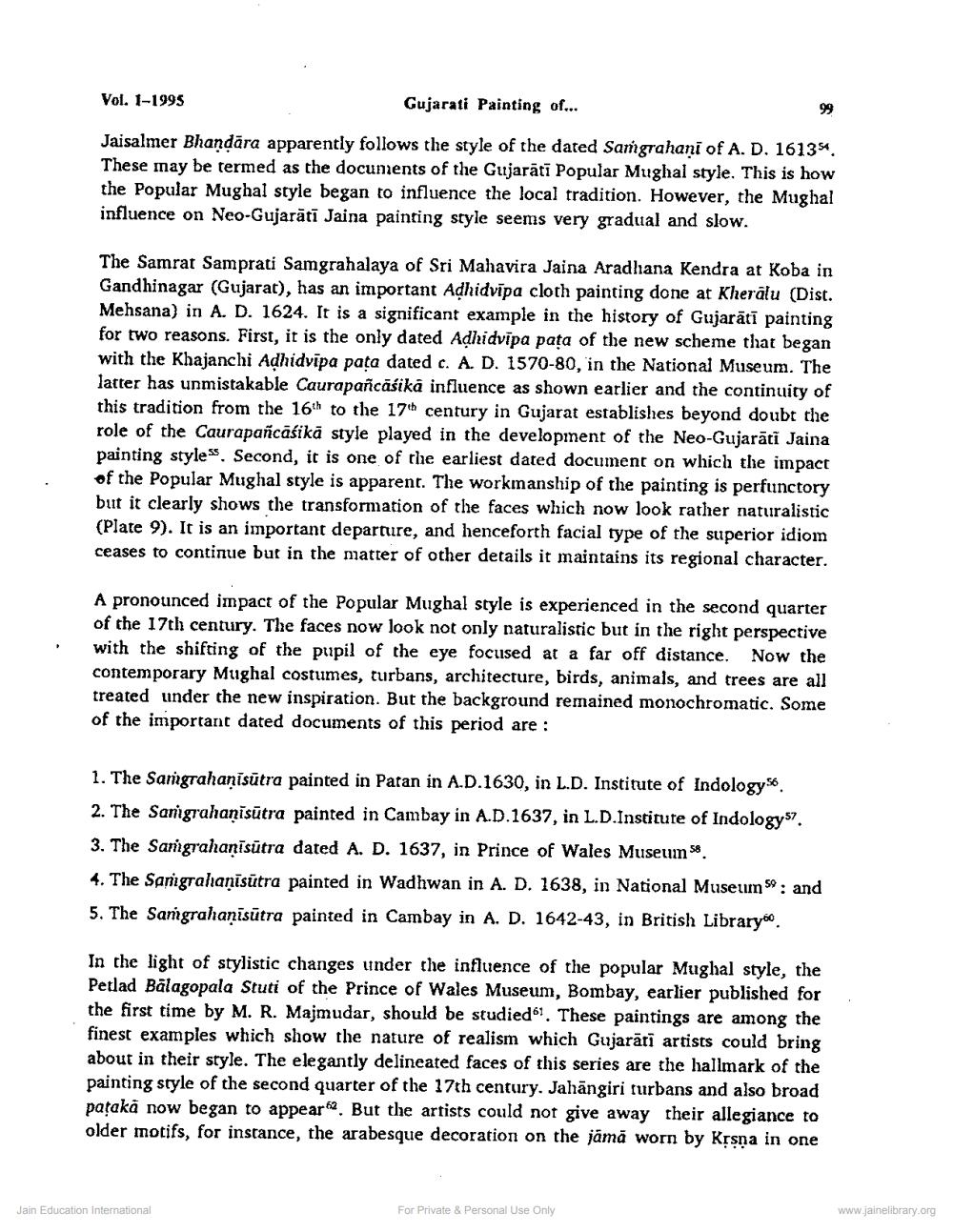Book Title: Gujarati Painting of 16th 17th Century Author(s): Lalit Kumar Publisher: Z_Nirgrantha_1_022701.pdf and Nirgrantha_2_022702.pdf and Nirgrantha_3_022703.pdf View full book textPage 8
________________ Vol. 1-1995 Gujarati Painting of... Jaisalmer Bhandāra apparently follows the style of the dated Sangrahani of A. D. 161354. These may be termed as the documents of the Gujarati Popular Mughal style. This is how the Popular Mughal style began to influence the local tradition. However, the Mughal influence on Neo-Gujarātī Jaina painting style seems very gradual and slow. The Samrat Samprati Samgrahalaya of Sri Mahavira Jaina Aradhana Kendra at Koba in Gandhinagar (Gujarat), has an important Adhidvipa cloth painting done at Kherālu (Dist. Mehsana) in A. D. 1624. It is a significant example in the history of Gujarātī painting for two reasons. First, it is the only dated Adhidvipa pata of the new scheme that began with the Khajanchi Adhidvīpa pata dated c. A. D. 1570-80, in the National Museum. The latter has unmistakable Caurapañcāśikā influence as shown earlier and the continuity of this tradition from the 16th to the 17th century in Gujarat establishes beyond doubt the role of the Caurapancāśikā style played in the development of the Neo-Gujarāti Jaina painting styles. Second, it is one of the earliest dated document on which the impact of the Popular Mughal style is apparent. The workmanship of the painting is perfunctory but it clearly shows the transformation of the faces which now look rather naturalistic (Plate 9). It is an important departure, and henceforth facial type of the superior idiom ceases to continue but in the matter of other details it maintains its regional character. A pronounced impact of the Popular Mughal style is experienced in the second quarter of the 17th century. The faces now look not only naturalistic but in the right perspective with the shifting of the pupil of the eye focused at a far off distance. Now the contemporary Mughal costumes, turbans, architecture, birds, animals, and trees are all treated under the new inspiration. But the background remained monochromatic. Some of the important dated documents of this period are : 1. The Sarigrahanīsūtra painted in Patan in A.D.1630, in L.D. Institute of Indology 2. The Sanigrahanisūtra painted in Cambay in A.D.1637, in L.D.Institute of Indology57. 3. The Sangrahanīsūtra dated A. D. 1637, in Prince of Wales Museun 58 4. The Sanigrahaņīsūtra painted in Wadhwan in A. D. 1638, in National Museums: and 5. The Sangrahaņīsūtra painted in Cambay in A. D. 1642-43, in British Libraryo In the light of stylistic changes under the influence of the popular Mughal style, the Petlad Balagopala Stuti of the Prince of Wales Museum, Bombay, earlier published for the first time by M. R. Majmudar, should be studied. These paintings are among the finest examples which show the nature of realism which Gujarāti artists could bring about in their style. The elegantly delineated faces of this series are the hallmark of the painting style of the second quarter of the 17th century. Jahāngiri turbans and also broad patakā now began to appear. But the artists could not give away their allegiance to older motifs, for instance, the arabesque decoration on the jāmā worn by Krsna in one www.jainelibrary.org Jain Education International For Private & Personal Use OnlyPage Navigation
1 ... 6 7 8 9 10 11 12 13 14 15 16 17 18
